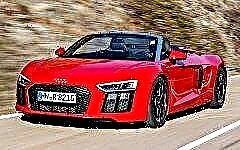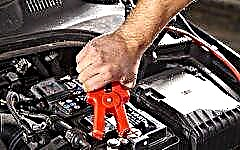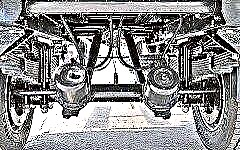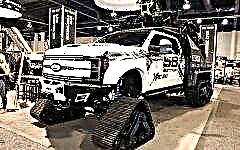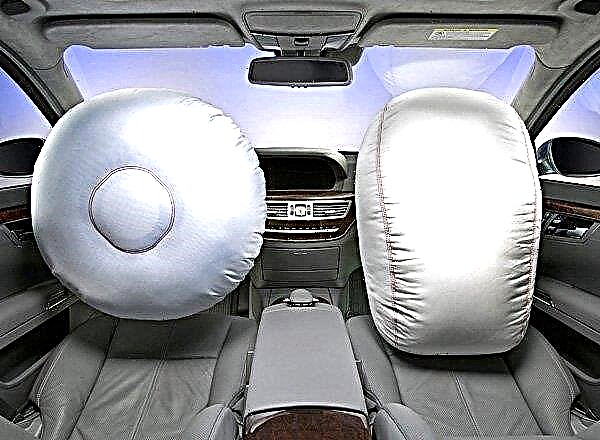Safety in a new car is an integral part, not an option. Consider the principle of operation, type and device of airbags.

The content of the article:
- Variety
- Frontal
- Side
- Blinds
- Knee
- Central
- For pedestrian
- How the mechanism works
- Principle of operation
- Conditions for triggering
An airbag is now much more often in demand as an option than, for example, an air conditioner or a modern audio system. The main purpose of airbags (in cars it is designated as airbag) is considered to mitigate the impact of passengers and the driver on the steering wheel, and other parts of the body, windows. As a rule, it is applied with seat belts. The security system was first introduced in 1953 when Walter Linderer published his patent.
Types of car airbags

As a rule, modern cars have several airbags. Previously, only the driver's airbag was installed, then it was added for the front passenger. In current models, they are installed around the entire perimeter, in different places in the cabin. By type, pillows are divided depending on their location. The first are frontal, then there are side, head, center airbags, knee and pedestrian airbags. The latter option is installed outside, between the bonnet and the windshield.
Frontal
They first found their application on Mercedes-Benz cars in 1981. As a rule, these are the front airbags for the driver and passenger. In turn, the passenger can be turned off at will. Often in modern cars, the design provides for a two-stage or multi-stage operation. It all depends on the severity of the accident (more often these are adaptive airbags). According to all the rules, the driver's airbag is installed in the steering wheel, for the front passenger - in the upper part of the front panel.
Side airbags
The main purpose of side pillows is considered to reduce the risk of injury to the pelvic region, chest and abdominal cavity. As a rule, side impact is one of the most unpredictable and painful. For the first time the use of side airbags on their cars was used by Volvo in 1994. This type of pillows was installed as an optional option, to the main front ones.
The seat back of the front seat is usually considered to be the location of the side cushions. Although in modern cars you can find them in the backs of the rear seats. Airbags with a two-chamber design are considered to be of the highest quality. The lower part is stiffer to protect the pelvis, and the upper part is softer to protect the ribcage.
Curtains or head cushions
Judging from the name, their main purpose is clear. In the list of car manufacturers, they still appear as curtains. In the event of a side impact, the curtains will protect your head from hitting the glass of the doors. Toyota was the first to use this technology in 1998.
Depending on the model of the car, it can be located in the front of the roof, also between the pillars and on the rear of the roof of the cabin. Protection is provided for the front and rear passengers.
Knee
The name itself, speaks of the purpose, the protection of the knees and legs from injury is very important in a collision. Often located under the steering wheel. They were first installed on Kia cars in 1996. In addition to the driver's, they are also installed for the front passenger, under the glove compartment.
Central protection
Since 2009, Toyota vehicles have been equipped with a central airbag. The main purpose is to reduce the secondary impact of passengers in side collisions. Often located in the armrest between the front row of seats. For the rear row of seats, it is located in the center of the backrest.
In modern cars, except for Toyota, the same ones are used in Mercedes-Benz cars (second generation Pre-Safe security system). Thus, in the event of a side impact, this airbag cushions the passenger's repeated return impact.
Pedestrian airbag
Since 2012, Volvo has been introducing a pedestrian airbag in its vehicles. Unlike all of the above options, this view is located outside the car, between the windshield and the hood. Thus, if the driver hits a pedestrian, the airbag will soften the impact and prevent serious injury.
Mechanism device

The device looks like a soft shell and is filled with gas at the right time, as well as a gas generator and a control system. The pillow itself is made of nylon fabric, in order to lubricate the pillow and not break during operation, talcum powder or starch is used. They can often be seen in the air during airbag deployment.
The main purpose of the gas generator is to fill the cushion itself with gas. Thus, it is already an airbag module. Gas generators differ among themselves in shape (tubular and round), in the nature of their operation (with two-stage and single-stage operation) and in the method of gas formation (hybrid and solid fuel). The most common is solid fuel, it consists of a body, a squib and a certain charge of solid fuel. Typically, the fuel is ignited by the squib, resulting in nitrogen gas.
A hybrid gas generator consists of an igniter, a high-pressure argon or compressed nitrogen gas charge, a housing and a solid fuel charge. The filling of the pillow itself occurs with compressed gas, as a result of expelling the charge from the solid fuel.
The cushion control system includes traditional impact sensors, a central control unit and an actuator (gas generator squib).
Principle of operation

The main start for activation is hit. Depending on which part and what force the blow is, only the necessary airbags are activated. As soon as an impact occurs, impact sensors are triggered, then information about the force and the place of impact is transmitted to the central control unit. The unit processes the received data and determines the need for specific airbags to be triggered, as well as their time and strength.
In parallel with the airbags, information is transmitted to other sensors and systems, for example, the emergency braking system or the SOS signal. If the force of the impact is not significant, then only the seat belts can work, or they can work together with the airbags.
Paired with a signal to different systems, a signal is sent to the gas generator of the respective airbags. On average, the response time of the airbags is about 40 ms. Thanks to the gas generator, the cushions are deployed and inflated. As soon as the pillow touches a person and works, it breaks and deflates.
Disposable airbags are always used in all vehicles. If there is a fire in the cabin and the temperature reaches 150-200 ° C, then the airbags will automatically work.
Conditions for triggering

The main conditions for the deployment of frontal airbags can be considered:
- exceeding the threshold (force) of the impact in a head-on collision;
- a sharp hit on a hard part at high speed (curb, sidewalk, pit wall, etc.);
- a firm landing after a car jump;
- fall of the car;
- oblique or direct impact to the front of the machine.
The front airbags will not deploy if the impact hits the side or rear. As a rule, in such cases, the side and rear ones will work.There is no standard triggering algorithm; it is often refined and improved. Modern algorithms take into account vehicle speed, deceleration rate, weight change and passenger location. Some manufacturers take into account the deployment force of the seat belt and the presence of a child seat in the passenger compartment.

